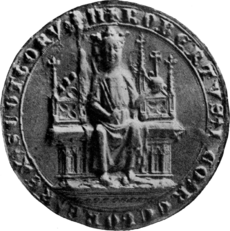Christina of the Isles facts for kids
Quick facts for kids
Christina of the Isles
|
|
|---|---|
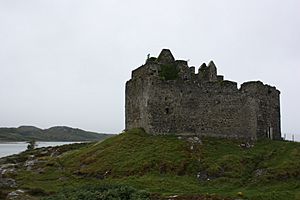
Now-ruinous Castle Tioram may well have been a Clann Ruaidhrí stronghold. The island the fortress sits upon—"insula sicca"—is first recorded in a charter of Christina.
|
|
| Predecessor | Ailéan mac Ruaidhrí |
| Successor | Ruaidhrí Mac Ruaidhrí |
| Noble family | Clann Ruaidhrí |
| Spouse(s) | Donnchadh |
| Issue | Ruaidhrí |
| Father | Ailéan mac Ruaidhrí |
| Mother | Isabella? |
Christina of the Isles lived around the late 1200s and early 1300s. She was an important Scottish noblewoman. She was the daughter of Ailéan mac Ruaidhrí and a key member of the powerful Clann Ruaidhrí family. Even though her father, Ailéan, had two sons, Lachlann and Ruaidhrí, they were not considered 'legitimate' heirs in the same way Christina was. She was likely the daughter of Ailéan's wife, Isabella.
A historical record from the 1300s says that Christina helped Robert I, King of Scotland during the First War of Scottish Independence. At that time, Robert was hiding from Edward I, King of England's forces. Another record from the same century suggests that when Robert fought back after Edward II died, he got important help from a female relative. This relative might have been Christina. Her support for Robert I, also known as Robert the Bruce, might have come from her marriage to Donnchadh. He was part of the Mar family, which was closely related to Robert's own Bruce family. It's also possible Christina was influenced by her mother's family, as her mother might have been a sister of Robert's mother.
Even though Christina was the rightful heir to her father's lands by law, her brothers probably controlled most of their family's large territories. Christina later gave up her rights to her brother Ruaidhrí. She did this with the condition that her own son would still get a share of the inheritance. After Ruaidhrí likely died in 1318, Christina tried to give most of the Clann Ruaidhrí lands to Artúr Caimbéal. This might have been part of a marriage agreement with the Caimbéalaigh (the Campbells). Despite this agreement, which might have had the king's approval, Christina's nephew, Ruaidhrí's son Raghnall Mac Ruaidhrí, became the chief of Clann Ruaidhrí.
Contents
Christina's Family Background
Christina was the daughter of Ailéan mac Ruaidhrí. Ailéan was the son of Ruaidhrí mac Raghnaill, Lord of Kintyre, who gave his name to the Clann Ruaidhrí family. Ailéan had two sons, Lachlann and Ruaidhrí. While Christina was considered a legitimate child, her brothers were not.
Ailéan was known to be alive in 1284 when he attended a government meeting. He was no longer mentioned in records by 1296, so he likely died before then. Ailéan's wife was Isabella, who was probably Christina's mother. After Ailéan died and before Alexander III, King of Scotland died, Isabella married Ingram de Umfraville. If Christina was still a child then, Ingram might have helped raise her.
In 1293, the Scottish parliament supported Ingram and Isabella's claim to land. This land was part of Isabella's dowry from her marriage to Ailéan. The same year, new sheriffdoms (areas controlled by a sheriff) were created in western Scotland. One of these was the sheriffdom of Skye, which included Clann Ruaidhrí lands. This area was put under the control of the Earl of Ross.
Helping Robert the Bruce
In 1296, Edward I, King of England invaded and easily took over Scotland. Like most other Scottish landowners, Lachlann and Christina showed their loyalty to the English king that August.
In February 1306, Robert Bruce VII, Earl of Carrick, who wanted to be King of Scotland, killed his main rival, John Comyn III of Badenoch. Robert became King Robert I in March. However, the English king quickly fought back and defeated Robert's forces in June. By September, Robert was a fugitive, meaning he was on the run. He seems to have escaped to the Hebrides islands.
According to a 1300s historical book called Gesta Annalia II, Christina played a very important role in Robert's survival. She gave him shelter along Scotland's western coast. Other historical books from the 1300s, the Chronicle of Lanercost and the Guisborough Chronicle, say that Robert received military help from Ireland and the Hebrides. Edward I certainly believed Robert was hiding among the western islands. This suggests that Christina likely provided significant help to Robert the Bruce with money, ships, and men.
| One possible way Christina and her husband were related to Robert I. Women are italicized. | |||||||||||||||||||||||||||||||||||||||||||||||||||||||||||||||||||||||||||||||||||||||||||||||||||||||||||||||||||||||||||||||||||||||||||||||||||||||||||||||||||||||||||||||||||||||||||||||||||||||||||||||||||||||||||||||||||||||||||||||||||||||||||||||||||||||||||||||||||||||||||||||||||||||||||||||||
|---|---|---|---|---|---|---|---|---|---|---|---|---|---|---|---|---|---|---|---|---|---|---|---|---|---|---|---|---|---|---|---|---|---|---|---|---|---|---|---|---|---|---|---|---|---|---|---|---|---|---|---|---|---|---|---|---|---|---|---|---|---|---|---|---|---|---|---|---|---|---|---|---|---|---|---|---|---|---|---|---|---|---|---|---|---|---|---|---|---|---|---|---|---|---|---|---|---|---|---|---|---|---|---|---|---|---|---|---|---|---|---|---|---|---|---|---|---|---|---|---|---|---|---|---|---|---|---|---|---|---|---|---|---|---|---|---|---|---|---|---|---|---|---|---|---|---|---|---|---|---|---|---|---|---|---|---|---|---|---|---|---|---|---|---|---|---|---|---|---|---|---|---|---|---|---|---|---|---|---|---|---|---|---|---|---|---|---|---|---|---|---|---|---|---|---|---|---|---|---|---|---|---|---|---|---|---|---|---|---|---|---|---|---|---|---|---|---|---|---|---|---|---|---|---|---|---|---|---|---|---|---|---|---|---|---|---|---|---|---|---|---|---|---|---|---|---|---|---|---|---|---|---|---|---|---|---|---|---|---|---|---|---|---|---|---|---|---|---|---|---|---|---|---|---|---|---|---|---|---|---|---|---|---|---|---|---|---|---|---|---|---|---|---|---|---|---|---|---|---|---|---|---|---|---|---|
|
|||||||||||||||||||||||||||||||||||||||||||||||||||||||||||||||||||||||||||||||||||||||||||||||||||||||||||||||||||||||||||||||||||||||||||||||||||||||||||||||||||||||||||||||||||||||||||||||||||||||||||||||||||||||||||||||||||||||||||||||||||||||||||||||||||||||||||||||||||||||||||||||||||||||||||||||||
| Another possible way Christina and her husband were related to Robert I. Women are italicized. | |||||||||||||||||||||||||||||||||||||||||||||||||||||||||||||||||||||||||||||||||||||||||||||||||||||||||||||||||||||||||||||||||||||||||||||||||||||||||||||||||||||||||||||||||||||||||||||||||||||||||||||||||||||||||||||||||||||||||||||||||||||||||||||||||||||
|---|---|---|---|---|---|---|---|---|---|---|---|---|---|---|---|---|---|---|---|---|---|---|---|---|---|---|---|---|---|---|---|---|---|---|---|---|---|---|---|---|---|---|---|---|---|---|---|---|---|---|---|---|---|---|---|---|---|---|---|---|---|---|---|---|---|---|---|---|---|---|---|---|---|---|---|---|---|---|---|---|---|---|---|---|---|---|---|---|---|---|---|---|---|---|---|---|---|---|---|---|---|---|---|---|---|---|---|---|---|---|---|---|---|---|---|---|---|---|---|---|---|---|---|---|---|---|---|---|---|---|---|---|---|---|---|---|---|---|---|---|---|---|---|---|---|---|---|---|---|---|---|---|---|---|---|---|---|---|---|---|---|---|---|---|---|---|---|---|---|---|---|---|---|---|---|---|---|---|---|---|---|---|---|---|---|---|---|---|---|---|---|---|---|---|---|---|---|---|---|---|---|---|---|---|---|---|---|---|---|---|---|---|---|---|---|---|---|---|---|---|---|---|---|---|---|---|---|---|---|---|---|---|---|---|---|---|---|---|---|---|---|---|---|---|---|---|---|---|---|---|---|---|---|---|---|---|---|---|---|---|---|
|
|||||||||||||||||||||||||||||||||||||||||||||||||||||||||||||||||||||||||||||||||||||||||||||||||||||||||||||||||||||||||||||||||||||||||||||||||||||||||||||||||||||||||||||||||||||||||||||||||||||||||||||||||||||||||||||||||||||||||||||||||||||||||||||||||||||

Christina's connections to the Mar kindred family could explain why she supported Robert the Bruce. She was married to a member of this noble family, but her husband's parents are not fully known. One idea is that her husband, Donnchadh, was a younger son of Uilleam, Earl of Mar. Another idea is that Donnchadh was a son of Uilleam's son, Domhnall I, Earl of Mar. We know that Domhnall I's daughter, Iseabail, was Robert's first wife. Also, Domhnall I's son, Gartnait, was married to Robert's sister. The fact that Christina was called a widow when she pledged loyalty to Edward I, on the same day Domhnall I's son Donnchadh also did, might mean her husband was indeed a son of Uilleam.
Later in 1307, around the time Edward I died, Robert made a strong comeback. He first took control of Carrick. Christina might have had more connections to the returning king. For example, her mother might have been from the Carrick family, perhaps a sister of Robert's mother, Marjorie, Countess of Carrick. According to the 1300s poem Bruce, while Robert was taking control in Carrick, he received supplies and soldiers from a woman described as a close relative. The poem says this unknown woman lent the king forty men. This number might match the forty merks (a type of land value) given to Ingram and Isabella in Carrick. More than two decades later, in 1328 or 1329, Robert gave forty shillings to someone named Christian of Carrick. If Christina's mother was indeed from the Carrick family and closely related to the king, Christina herself could be the relative mentioned in the poem and the person who received the money.
Ruaidhrí and the Clann Ruaidhrí Leadership
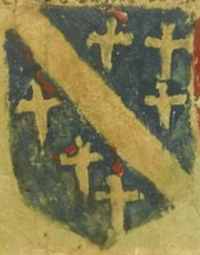
While Christina consistently supported Robert the Bruce, her half-brothers seem to have been more ambitious and changed sides when it suited them. Lachlann was last mentioned in records in 1307 or 1308. After this, Ruaidhrí seems to have taken over from Lachlann.
Even though Christina was her father's only legitimate child, it's unlikely that the family only considered legitimate birth for leadership. As the main male member of Clann Ruaidhrí at that time, Ruaidhrí probably controlled the family's large territories. However, Ruaidhrí seems to have only officially gained his rights to the lordship after Christina gave up her own claims. This was done through a charter (a legal document) confirmed by Robert I himself.
Christina's claim to the lordship and her close ties to Robert might have been a threat to Ruaidhrí and his descendants. Also, Christina had a son, also named Ruaidhrí. He could have asked the king for help to pursue his mother's claims. The name Christina gave her son might mean he was named after his grandfather and was meant to be a future leader of Clann Ruaidhrí. Christina gave up her claims with the condition that if her brother died without a male heir, and if her son married one of her brother's daughters, Christina's son would inherit the lands. This document doesn't have a date, but it seems to have been granted early in Robert's reign, possibly before 1310.
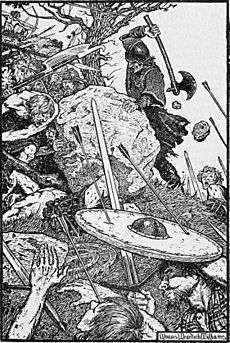
It's possible that the king arranged Ruaidhrí's succession to ensure continued support from Clann Ruaidhrí. They were one of the most powerful families on the western coast. On the other hand, Christina, a close ally of Robert, was replaced by Ruaidhrí, who had a less stable political past. This might mean that Ruaidhrí's control came more from family politics than from the king's involvement. The agreement between Christina and Ruaidhrí stated that the Clann Ruaidhrí lordship should stay in the male line of the family, at least for a while. But it also recognized Christina's rights to the inheritance. While Christina's son's father might have been Donnchadh, the fact that her son wasn't specifically named as her heir could mean he was not legitimate.
In any case, Ruaidhrí was likely already seen as the rightful chief. The charter also officially made him dependent on the Scottish Crown. Ruaidhrí's lands included the mainland areas of Moidart, Arisaig, Morar, and Knoydart. It also included the islands of Rhum, Eigg, Barra, St Kilda, and Uist. This territory was as large as any of the kingdom's thirteen earldoms. However, during this time, other western families like Clann Domhnaill and the Caimbéalaigh (Campbells) were given many lands. These lands came from the Clann Dubhghaill territories that the king had taken away. The disagreements within Clann Ruaidhrí might explain why they didn't gain as much land after Clann Dubhghaill's fall.
Raghnall and the Clann Ruaidhrí Succession

Ruaidhrí seems to be the same Clann Ruaidhrí leader who died fighting for the Bruce campaign in Ireland in 1318. Even though Ruaidhrí seemed to secure his family's future, there's evidence that Christina challenged the Clann Ruaidhrí inheritance after his death. At the time Ruaidhrí died, his son, Raghnall, might have been too young to rule. It seems Christina and her allies tried to take control of the inheritance again. Although she gave up her claims to a certain Artúr Caimbéal after Ruaidhrí's death, Raghnall successfully took control of the region. Most of his family saw him as the chief of Clann Ruaidhrí.
One idea is that Christina's plan with Artúr was part of a marriage alliance between her and Artúr's family, the Caimbéalaigh. Robert I is known to have given control of Dunstaffnage Castle, a former Clann Dubhghaill stronghold, to an Artúr Caimbéal. The exact identity of this officer is unclear, as there were a father and son with the same name. While the older Artúr might have received control of the castle, Christina's deal seems to have been with the constable's son, who she might have intended to marry.

In 1325, a person named "Roderici de Ylay" had their possessions taken away by Robert I. This record might refer to a member of Clann Domhnaill, but it could also refer to a member of Clann Ruaidhrí. If it refers to Clann Ruaidhrí, the person might have been Raghnall himself. If so, his lands might have been taken because he resisted Christina's attempts to take the Clann Ruaidhrí estate from him and give it to the Caimbéalaigh. Or, the lands might have been taken because Clann Ruaidhrí was expanding into neighboring areas, like the former lands of the defeated Clann Dubhghaill.
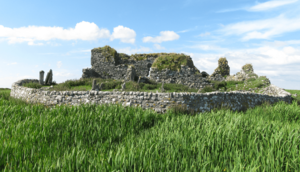
Christina's charter to Artúr doesn't have a date, but it might be from just before the lands were taken away. The list of witnesses who signed the document is notable. It suggests the charter had the king's approval. The witnesses included important men like John Menteith and Domhnall Caimbéal. These men were all close supporters of Robert I against Clann Dubhghaill. They represented powerful families along the western coast. An alliance of such men could have been very intimidating to the Clann Ruaidhrí leaders.
The king might have personally enforced the taking of lands. He seems to have traveled to Tarbert Castle, a strong royal fortress, in the same year. It's thought that the Caimbéalaigh's control of Dunstaffnage Castle was part of a plan to create a new western sheriffdom based at Tarbert. Although the king had allowed Raghnall's father to succeed earlier, by the early 1320s, the Scottish Crown was helping families like the Caimbéalaigh expand at the expense of families like Clann Ruaidhrí. In fact, it might have been at the Scone parliament in 1323 that the Caimbéalaigh were given control of the castle and lands in Benderloch and other places. This royal grant might have canceled earlier grants of former Clann Dubhghaill lands to members of Clann Ruaidhrí.

Christina's charter to Artúr gave him the territories of Moidart, Arisaig, Morar, and the islands of Eigg and Rhum. It also included Eilean Tioram. In return, Artúr and his heirs had to provide a ship with twenty oars for the King of Scotland's army. While Christina's charter included most of the Clann Ruaidhrí lands mentioned in her brother's earlier royal grant, it didn't mention a large area of lands on Uist. One possibility is that Christina wanted to keep these island territories for herself or a male representative of Clann Ruaidhrí. She might have wanted to give the main part of the family estate to the Caimbéalaigh. On the other hand, it's also possible that the unmentioned island territories were no longer part of the Clann Ruaidhrí lordship.

Two later documents confirm that Christina gave Teampull na Trionaid (Church of the Holy Trinity) and some lands on Uist to Inchaffray Abbey. The first confirmation is from 1389 by Gofraidh Mac Domhnaill, whose mother was Áine Nic Ruaidhrí, Christina's niece. The second confirmation is from 1410 by Gofraidh's half-brother, Domhnall Mac Domhnaill, Lord of the Isles. While these confirmations might show that Christina indeed made these church grants, it's also possible they are not entirely accurate. For example, the records might have been made up to include Christina to help the land claims of the Clann Domhnaill branch descended from Gofraidh. However, if the confirmations are true, they could mean Christina was giving away lands that other family members used to hold, lands that might have been taken away. Also, if the confirmations are true, Christina's support for Inchaffray Abbey could further show her connection with the Bruce family, as Robert I himself supported this religious house.

Christina's agreement with Artúr might have had consequences later on. For example, two Highland chiefs were executed in 1428: Alasdair Mac Ruaidhrí and Eóin Mac Artair. Both were said to command a thousand men each. We are not entirely sure who these men were. However, Alasdair Mac Ruaidhrí might have been a member of Clann Ruaidhrí. Eóin Mac Artair might have been from the Strachur branch of the Caimbéalaigh, and possibly a descendant of Artúr himself. If so, these executed chiefs might have been continuing a feud that started from Christina's disputed inheritance and her connections with the Caimbéalaigh.
A papal document from 1393 states that Christina gave the island of Davaar to Saddell Abbey. According to a 1900s story from Uist, Christina was linked to a school at a local nunnery where girls were taught crafts.
Christina in Stories
Christina is an important character in The Path of the Hero King, which is the second part of Nigel Tranter's series of books about Robert the Bruce.


